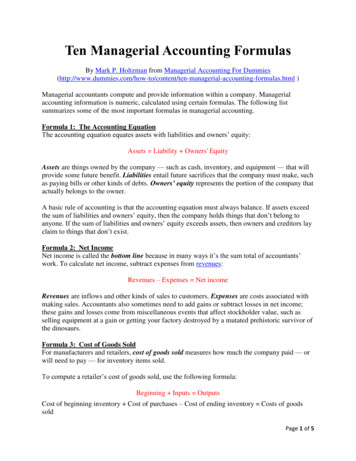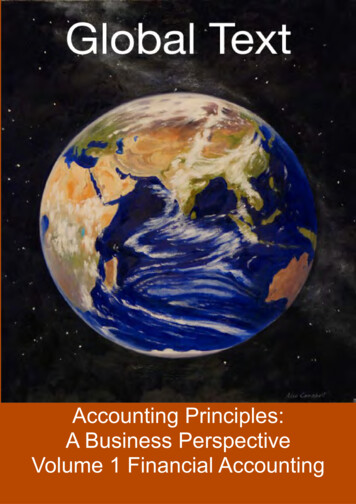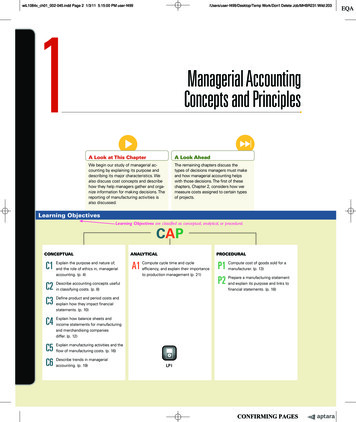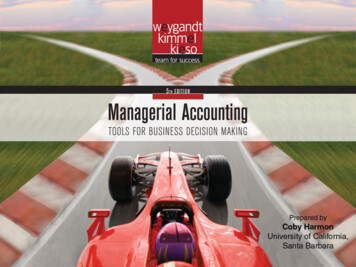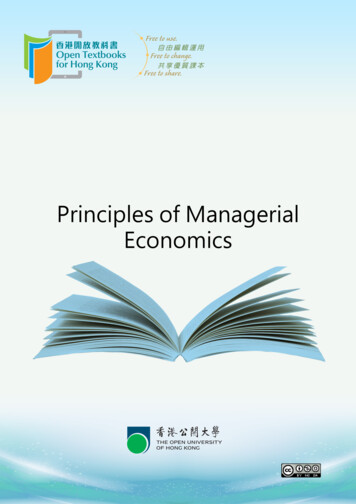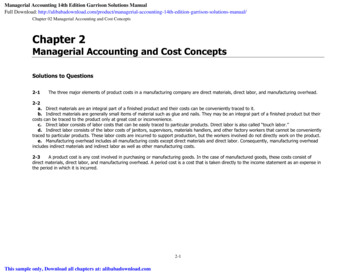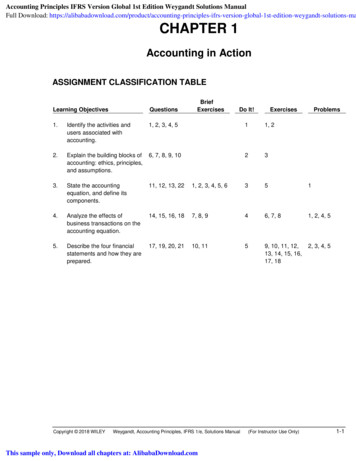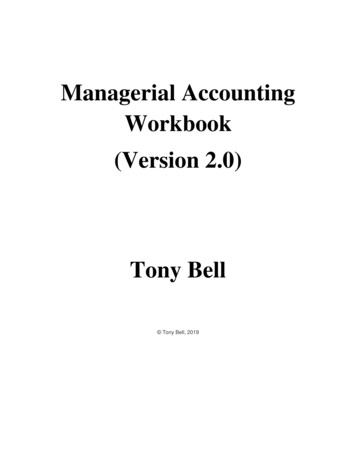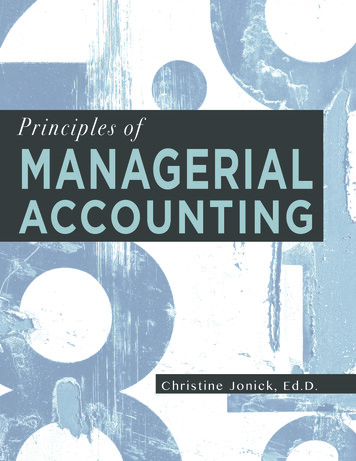
Transcription
Principles ofMANAGERIALACCOUNTINGC h r i s t i n e J o n i c k , E d . D.
Principles ofMANAGERIALACCOUNTINGC h r i s t i n e J o n i c k , E d . D.Blue Ridge Cumming Dahlonega Gainesville Oconee
Principles of Managerial Accounting is licensed under a Creative Commons AttributionShareAlike 4.0 International License.This license allows you to remix, tweak, and build upon this work, even commercially, aslong as you credit this original source for the creation and license the new creation underidentical terms.If you reuse this content elsewhere, in order to comply with the attribution requirements ofthe license please attribute the original source to the University System of Georgia.NOTE: The above copyright license which University System of Georgia uses for theiroriginal content does not extend to or include content which was accessed and incorporated,and which is licensed under various other CC Licenses, such as ND licenses. Nor does itextend to or include any Special Permissions which were granted to us by the rightsholdersfor our use of their content.Image Disclaimer: All images and figures in this book are believed to be (after a reasonableinvestigation) either public domain or carry a compatible Creative Commons license. If youare the copyright owner of images in this book and you have not authorized the use of yourwork under these terms, please contact the University of North Georgia Press at ungpress@ung.edu to have the content removed.Published by:University of North Georgia PressDahlonega, GeorgiaCover Design and Layout Design:Corey ParsonCover Image:Scott Rodgerson, CC0ISBN: 978-1-940771-45-8Printed in the United States of America, 2017For more information, please visit: http://ung.edu/university-pressOr email: ungpress@ung.eduIf you need this document in another format, please email the University of North Georgia Press atungpress@ung.edu or call 706-864-1556.
TABLEOFC ONTENT SChapter 1: Managerial Accounting Concepts 11.1 Introduction . . . . . . . . . . . . . . . . . . . . . . . . . . . . . . . . . . . . . . . . . . . . . . . . . . . . . 11.2 Cost terminology and concepts . . . . . . . . . . . . . . . . . . . . . . . . . . . . . . . . . . . . 31.3 Inventory terminology and concepts . . . . . . . . . . . . . . . . . . . . . . . . . . . . . . . 4Chapter 2: Job Order Costing102.1 Introduction . . . . . . . . . . . . . . . . . . . . . . . . . . . . . . . . . . . . . . . . . . . . . . . . . . 102.2 Comprehensive Example of Job Order Costing Transactionsfor a Manufacturing Company . . . . . . . . . . . . . . . . . . . . . . . . . . . . . . . . . . . . . . . 172.3 Job Order Costing for a Service Company . . . . . . . . . . . . . . . . . . . . . . . . . 26Chapter 3: Process Costing293.1 Introduction . . . . . . . . . . . . . . . . . . . . . . . . . . . . . . . . . . . . . . . . . . . . . . . . . . 293.2 Process Costing Transactions for a Manufacturing Company . . . . . . . . . 303.3 Process Costing Calculations for a Department in aManufacturing Company . . . . . . . . . . . . . . . . . . . . . . . . . . . . . . . . . . . . . . . . . . . 36Chapter 4: Activity-Based Costing424.1 Introduction . . . . . . . . . . . . . . . . . . . . . . . . . . . . . . . . . . . . . . . . . . . . . . . . . . 424.2 Single factory rate to estimate factory overhead . . . . . . . . . . . . . . . . . . . . 434.3 Departmental rates to estimate factory overhead . . . . . . . . . . . . . . . . . . . 444.4 Activity-based costing for a manufacturing business to estimatefactory overhead . . . . . . . . . . . . . . . . . . . . . . . . . . . . . . . . . . . . . . . . . . . . . . . . . . 454.5 Differences based on factory overhead method . . . . . . . . . . . . . . . . . . . . . 48
4.6 Activity-based costing for a manufacturing business to estimatefactory overhead . . . . . . . . . . . . . . . . . . . . . . . . . . . . . . . . . . . . . . . . . . . . . . . . . . 484.7 Activity-based costing for a service business to estimatefactory overhead . . . . . . . . . . . . . . . . . . . . . . . . . . . . . . . . . . . . . . . . . . . . . . . . . . 49Chapter 5: Cost Volume Profit Analysis515.1 Introduction . . . . . . . . . . . . . . . . . . . . . . . . . . . . . . . . . . . . . . . . . . . . . . . . . . . 515.2 Cost Volume Profit Analysis (CVP) . . . . . . . . . . . . . . . . . . . . . . . . . . . . . . . 545.3 Breakeven Point . . . . . . . . . . . . . . . . . . . . . . . . . . . . . . . . . . . . . . . . . . . . . . . 585.4 Operating leverage . . . . . . . . . . . . . . . . . . . . . . . . . . . . . . . . . . . . . . . . . . . . . 645.5 Margin of safety . . . . . . . . . . . . . . . . . . . . . . . . . . . . . . . . . . . . . . . . . . . . . . . 65Chapter 6: Variable Costing Analysis676.1 Introduction . . . . . . . . . . . . . . . . . . . . . . . . . . . . . . . . . . . . . . . . . . . . . . . . . . 676.2 Units manufactured equals units sold . . . . . . . . . . . . . . . . . . . . . . . . . . . . . 696.3 Units manufactured greater than units sold . . . . . . . . . . . . . . . . . . . . . . . . 706.4 Units manufactured less than units sold . . . . . . . . . . . . . . . . . . . . . . . . . . . . 716.5 Analysis of variable and absorption costing . . . . . . . . . . . . . . . . . . . . . . . . 726.6 Contribution margin analysis . . . . . . . . . . . . . . . . . . . . . . . . . . . . . . . . . . . . 74Chapter 7: Budgeting807.1 Introduction . . . . . . . . . . . . . . . . . . . . . . . . . . . . . . . . . . . . . . . . . . . . . . . . . . 807.2 Static Budget . . . . . . . . . . . . . . . . . . . . . . . . . . . . . . . . . . . . . . . . . . . . . . . . . . 807.3 Flexible Budget . . . . . . . . . . . . . . . . . . . . . . . . . . . . . . . . . . . . . . . . . . . . . . . . . 817.4 Master Budget . . . . . . . . . . . . . . . . . . . . . . . . . . . . . . . . . . . . . . . . . . . . . . . . . 827.5 Operating Budget . . . . . . . . . . . . . . . . . . . . . . . . . . . . . . . . . . . . . . . . . . . . . . 827.6 Sales Budget . . . . . . . . . . . . . . . . . . . . . . . . . . . . . . . . . . . . . . . . . . . . . . . . . . 867.7 Cost of Goods Sold Budget . . . . . . . . . . . . . . . . . . . . . . . . . . . . . . . . . . . . . . 90
7.8 Selling and Administrative Cost Budget . . . . . . . . . . . . . . . . . . . . . . . . . . . 927.9 Budgeted Income Statement . . . . . . . . . . . . . . . . . . . . . . . . . . . . . . . . . . . . . 937.10 Cash Budget . . . . . . . . . . . . . . . . . . . . . . . . . . . . . . . . . . . . . . . . . . . . . . . . . 947.11 Capital Expenditure Budget . . . . . . . . . . . . . . . . . . . . . . . . . . . . . . . . . . . . . 96Chapter 8: Variance Analysis988.1 Introduction . . . . . . . . . . . . . . . . . . . . . . . . . . . . . . . . . . . . . . . . . . . . . . . . . . 988.2 Direct materials cost variance . . . . . . . . . . . . . . . . . . . . . . . . . . . . . . . . . . . 998.3 Direct labor cost variance . . . . . . . . . . . . . . . . . . . . . . . . . . . . . . . . . . . . . . 1008.4 Factory overhead variances . . . . . . . . . . . . . . . . . . . . . . . . . . . . . . . . . . . . . 101Chapter 9: Differential Analysis1059.1 Introduction . . . . . . . . . . . . . . . . . . . . . . . . . . . . . . . . . . . . . . . . . . . . . . . . . 1059.2 Make or buy a component part . . . . . . . . . . . . . . . . . . . . . . . . . . . . . . . . . . 1069.3 Continue with or discontinue a product . . . . . . . . . . . . . . . . . . . . . . . . . . . 1079.4 Lease or sell equipment . . . . . . . . . . . . . . . . . . . . . . . . . . . . . . . . . . . . . . . . 1089.5 Sell a product or process further . . . . . . . . . . . . . . . . . . . . . . . . . . . . . . . . 1099.6 Keep or replace a fixed asset . . . . . . . . . . . . . . . . . . . . . . . . . . . . . . . . . . . . . 1109.7 Accept business at reduced price . . . . . . . . . . . . . . . . . . . . . . . . . . . . . . . . . 1109.8 Capital investment analysis . . . . . . . . . . . . . . . . . . . . . . . . . . . . . . . . . . . . . 111
1Managerial Accounting Concepts1.1 INTRODUCTIONAccounting is the system of recording and keeping track of financialtransactions in a business and summarizing this information in reports. Thesereports provide information to people who are interested in knowing about thefinancial aspects of a business. The information guides business managers,investors, and creditors in planning and decision making. In fact, accountingis often referred to as “the language of business” because business peoplecommunicate, evaluate performance, and determine value using dollars andamounts generated by the accounting process.Financial accounting involves producing periodic reports called financialstatements to inform such external groups as investors, boards of directors,creditors, and government/tax agencies about a company’s financial performanceand status. The income statement, retained earnings statement, balance sheet, andstatement of cash flows are published at fixed intervals to summarize the historicalearnings performance and current financial position of a company. Financialstatements are prepared according to Generally Accepted Accounting Principles(GAAP), which helps ensure the information is relevant (useful and timely formaking decisions), reliable (accurate and unbiased), consistent (prepared thesame way each time information is reported), and comparable (prepared thesame way by different companies).Managerial accounting is targeted more toward a company’s managers andemployees. The information gathered and summarized for these internal groupsis customized to provide feedback for planning, decision making, and evaluationpurposes. Managerial reports do not necessarily follow any particular format, butinstead are uniquely designed to meet the needs of specific users. Analyses areoften focused on targeted segments of a business rather than on a company asa whole. Information may be published over periodic time intervals or on an asneed basis. Managerial accounting involves not only actual financial data frompast periods, but also current estimates and future projections.A manager’s responsibilities in a business include making decisions relatedto planning (identifying goals and strategies for accomplishing them), leading(directing daily operations and carrying out plans), and controlling (comparingPage 1
PRINCIPLES OF MANAGERIAL ACCOUNTINGMANAGERIAL ACCOUNTING CONCEPTSexpected and actual results and taking action for improvement). Since human,financial, and time resources are limited, managers must select from among manyalternatives, foregoing other options. They try to optimize the collective outcomeof their choices. Managerial accounting provides timely and relevant financialinformation that contributes to effective decision making.A business’s operations are classified as one of three types - service,merchandising, or manufacturing - depending on what it has for sale. A servicebusiness sells expertise, advice, assistance, professional skills, or an experiencerather than a physical product. A merchandising business purchases finishedand packaged products from other companies, marks up the costs of these items,and sells them to customers. A manufacturing business assembles and packagesproducts for sale to merchandisers or end users.Managerial accounting is relevant to all three types of businesses. In thisdocument, we will focus on manufacturing since that type of business involvesthe most in-depth facets and examples of managerial accounting. We will alsodiscuss managerial accounting for service businesses where appropriate. Topicswill fall into four broad categories: accumulating costs, analyzing costs, evaluatingperformance, and comparing alternatives.The goal of a business is to generate profit, which is the difference betweenincome and costs in a particular time period. Costs are the result of paying cashor committing to pay cash in the future in order to earn revenue. Costs may beaccumulated for a product, sales territory, department, or activity. It is critical toanalyze costs because controlling them directly impacts profitability. Costs are alsoused to determine selling prices of products, and they are monitored over time toevaluate progress and discover irregularities.ACCUMULATING COSTSCosts must be determined and recorded accurately, systematically, and on atimely basis. Unless cost information is correct and reliable, it is not very usefulto managers who depend on it to make effective plans and informed decisions.Job order costing and process costing are two methods of systematicallyaccumulating costs on manufactured products. Activity-based costing is asystem that is combined with the other two methods to identify and measure costsmore specifically.ANALYZING COSTSNot all costs are created equal. Some are unavoidable; others are somewhatcontrollable. Separating them out allows managers to focus on controllable coststhat should be monitored in order to contain or lower them. Costs may also be usedto mathematically determine sales required to achieve desired levels of volumeand profitability. Break even analysis and other cost relationships, as well asPage 2
PRINCIPLES OF MANAGERIAL ACCOUNTINGMANAGERIAL ACCOUNTING CONCEPTSvariable costing, will address these issues.EVALUATING PERFORMANCEPlanning involves looking into the future and estimating what a business’sfinancial activities will look like. This process is called budgeting and projectswhat sales, costs, production, cash flows, etc. will be in at a future point in time.Controlling methods such as variance analysis compare expected outcomes toactual results and analyze overall progress in meeting goals.COMPARING ALTERNATIVESManagerial decision making includes choosing one option over others, such aswhether to make or buy a component part or whether to continue manufacturinga product or not. Differential analysis compares alternatives to determinewhich choice will yield either the greatest benefit or the least cost. Capitalinvestment analysis is a type of differential analysis that involves evaluatingproposed investments in property, plant, and equipment that a company will usein its operations.1.2 COST TERMINOLOGY AND CONCEPTSFor a manufacturing company, a significant goal of managerial accounting isto keep track of the costs of the units that are produced. A cost is a current orfuture expenditure of cash for something that will ultimately generate revenue. Inmanufacturing, many costs relate to products that are ultimately sold to customers.Period costs include selling and administrative expenses that are unrelatedto the production process in a manufacturing business. Selling expenses areincurred to market products and deliver them to customers. Administrativeexpenses are required to provide support services that are not directly related to themanufacturing or selling activities. Administrative costs may include expendituresfor a company’s accounting department, human resources department, andpresident’s office. Selling and administrative expenses may also include utilities,insurance, property taxes, depreciation, supplies, maintenance, salaries, etc., thatare incurred in a business, but outside of the factory production area.Product costs are incurred when a company manufactures goods. Productcosts may be classified as either direct or indirect. Direct costs are expendituresin a factory that can be specifically traced to a manufactured item and that becomepart of its overall cost. Indirect costs are also incurred in a factory whereproduction takes place, but they are more general and cannot be attributed to anyspecific product.There are three product costs associated with a manufactured item:1. Direct materials2. Direct labor costPage 3
PRINCIPLES OF MANAGERIAL ACCOUNTINGMANAGERIAL ACCOUNTING CONCEPTS3. Factory overheadDirect materials are raw materials that will be used to create finished goods.Their cost becomes part of the product that customers ultimately purchase.Direct labor is the cost of hourly wages of production workers who assemblemanufactured goods. These employees work on products that are sold to customerswhen finished.Factory overhead is an indirect cost and includes ANY expense in a factorythat is not specifically traced to products that customers purchase. These may begeneral expenses, such as utilities, insurance, property taxes, depreciation, supplies,maintenance, supervisor salaries, and expired prepaid items. Factory overhead alsoincludes any materials or labor that do not become part of a manufactured product.Product costs may be further categorized, as follows:1. Prime cost direct labor direct materials2. Conversion costs direct labor factory overheadEXAMPLEA manufacturing company produces kitchen cabinets. Direct materialsinclude wood, hinges, and hardware. Direct labor is the cost of wages of factoryemployees who assemble the cabinets. Factory overhead includes expendituresfor electricity and water bills, insurance premiums, roof repair, depreciation ofmachinery, materials used to build shelves in the factory, and wages of factoryworkers to assemble those shelves.Assume that direct materials cost 700, direct labor is 500, and factoryoverhead is 300 for cabinets that have been manufactured.1. How much are prime costs? 700 500 1,2002. How much are conversion costs? 500 300 8003. What is the total cost of the product? 700 500 300 1,5001.3 INVENTORY TERMINOLOGY AND CONCEPTSA manufacturer reports its product costs as one of three types of inventory inthe current assets section of its balance sheet, depending on stages of completion.Materials consist of items in inventory that have not yet been entered intoproduction or used. Work in process includes manufactured products thathave been started but are not yet completed. In other words, they are currently inproduction. Finally, finished goods are manufactured products that have beencompleted but not yet sold to customers.1.3.1 Financial Reporting for a ManufacturerThe three inventory accounts, and their balances at the end of the month,appear in the current asset section of a manufacturer’s balance sheet. A samplePage 4
PRINCIPLES OF MANAGERIAL ACCOUNTINGMANAGERIAL ACCOUNTING CONCEPTSbalance sheet follows.Jonick CompanyBalance SheetJune 30, 2019AssetsCurrent assets:Cash 40,000Accounts receivable25,000InventoryMaterials 18,000Work in process31,000Finished goods26,000Total inventory75,000Prepaid insurance4,000Prepaid rent2,000Total current assets 146,000When manufactured items are sold, their costs are removed from the FinishedGoods inventory account and transferred to the Cost of Goods Sold expense accounton the income statement. Cost of Goods Sold represents the amount a companypaid for the manufactured items that it sold. Cost of Goods Sold is matched withSales on the first two rows of the income statement. The difference between Salesand Cost of Goods Sold is gross profit, which is the amount of markup on themanufactured goods.The income statement also includes expenses other than Cost of Goods Sold.Selling and administrative expenses are non-factory costs that are classified asoperating expenses. These period costs are necessary to operate the business andgenerate sales.A sample income statement follows.Jonick CompanyIncome StatementFor the Month Ended June 30, 2018Sales 300,000140,000Cost of goods soldGross profits 160,000Operating expenses:Selling expenses 75,000Administrative expenses35,000110,000Total operating expensesPage 5
PRINCIPLES OF MANAGERIAL ACCOUNTINGMANAGERIAL ACCOUNTING CONCEPTSNet income 50,000The Cost of Goods Sold amount on the income statement is determined byconsidering the changes in the three inventory account balances during the period.The elements of its calculation contain important information for managers, butthey are too detailed and lengthy to present directly on the income statement.Therefore, a separate statement of cost of goods sold is prepared to show thedetails of the calculations. The final cost of goods sold amount from the statementof cost of goods sold is what appears on the income statement.The statement of cost of goods sold that follows presents how the 140,000amount on the income statement is determined. The statement is followed by anexplanation of its sections.Jonick CompanyStatement of Cost of Goods SoldFor the Month Ended June 30, 2019Finished goods inventory, June 1 34,000Work in process inventory, June 1 42,000Direct materialsMaterials inventory, June 1Purchases 16,00059,000Cost of materials available to use 75,000Materials inventory, June 30(18,000)Cost of direct materials used 57,000Direct labor40,000Factory overhead24,000121,000Total manufacturing costs in JuneTotal manufacturing costs 163,000(31,000)Work in process inventory, June 30132,000Cost of goods manufactured 166,000Cost of goods available for sale(26,000)Finished goods inventory, June 30 140,000Cost of goods soldThree amounts that must often be solved for algebraically are the amounts ofinventory transferred out of the Materials, Work in Process, and Finished Goodsinventory accounts during a period. These amounts may be determined with anequation similar to that used for the periodic inventory system for merchandising.Beginning and ending inventory values are determined by taking physical inventorycounts, and, therefore, they are known. Amounts for inventory added during theperiod are available from purchase orders and production reports that accumulatecosts on manufactured goods. The following general equation summarizes thecalculation of inventory transferred out of the inventory accounts:Page 6
PRINCIPLES OF MANAGERIAL ACCOUNTINGMANAGERIAL ACCOUNTING CONCEPTSBeginning inventory balance additions during the month – ending inventory balanceThe equations that follow for each inventory account use the amounts fromthe statement of cost of goods sold to illustrate the calculations for the amountstransferred out of Materials, Work in Process, and Finished Goods, respectively.The ledger account that corresponds to each type of inventory uses these sameamounts to show increases, decreases, and running balances. The ledger accountsshow the flow of manufacturing costs from Materials to Work in Process toFinished Goods to Cost of Goods Sold.MaterialsBeginning Materials balance Purchases of materials during the period- Ending Materials balance (still in inventory) 16,000 59,000- 18,000 Materials used and transferred to Work in Process 57,000The following ledger also reflects the movement in and out of the Materialsaccount, with a debit entry representing an increase and a credit entry showing adecrease.MaterialsDate ItemDebit1.Balance, June 12.Purchases of materials during June3.Materials moved to production in 0The following excerpt from the statement of cost of goods sold presents theinformation shown in the equation and ledger for Materials.Direct materialsMaterials inventory, June 1Purchases 16,000 57,000 was transferredfrom one inventory accountto the next: from Materials(credit) to Work in Process(debit)59,000Cost of materials available to use 75,000Materials inventory, June 30(18,000)Cost of direct materials used 57,000Work in ProcessBeginning Work in Process balance Materials, labor, and factory overhead added to production- Ending Work in Process balance (still in inventory) Work in Process completed and transferred to Finished Goods 42,000 121,000- 31,000 132,000The following ledger also reflects the movement in and out of the Work inPage 7
PRINCIPLES OF MANAGERIAL ACCOUNTINGMANAGERIAL ACCOUNTING CONCEPTSProcess account, with a debit entry representing an increase and a credit entry adecrease.Work in ProcessDateItem1.Balance, June 1DebitCreditDebitCredit2.Materials moved to production in June57,00099,0003.Labor added to production in June40,000139,0004.Overhead added to production in June24,000163,0005.Work in process completed in June42,000132,00031,000The following excerpt from the statement of cost of goods sold presents theinformation shown in the equation and ledger for Work in Process.Work in process inventory, June 1 42,000 132,000 wastransferred from oneinventory account tothe next: from Workin Process (credit) toFinished Goods (debit)121,000Total manufacturing costs in JuneTotal manufacturing costs 163,000(31,000)Work in process inventory, June 30132,000Cost if goods manufacturedFinished GoodsBeginning Finished Goods balance Work in Process completed during the period- Ending Finished Goods balance (not yet sold) 34,000 132,000- 26,000 Finished Goods sold and transferred to Cost of Goods Sold 140,000The following ledger also reflects the movement in and out of the FinishedGoods account, with a debit entry representing an increase and a credit entry adecrease.Finished GoodsDate ItemDebit1.Balance, June 12.Work in process completed in June3.Cost of product sold in ,000The following excerpt from the statement of cost of goods sold presents theinformation shown in the equation and ledger for Finished Goods.Page 8
PRINCIPLES OF MANAGERIAL ACCOUNTINGMANAGERIAL ACCOUNTING CONCEPTSFinished goods inventory, June 1 34,000Cost of goods manufactures132,000 166,000Cost of goods available for sale(26,000)Finished goods inventory, June 30 140,000Cost of goods sold 140,000 was transferred from one inventory account to thenext: from FinishedGoods (credit) to Costof Good Sold (debit)Cost of Goods Sold: 140,000 was transferred from one inventory account to an expense accountwhen the product was sold: from Finished Goods (credit) to Cost of Goods Sold(debit)Cost of Goods SoldDateItemDebit1.Cost of product sold in June140,000CreditDebitCredit140,000The accumulation of production costs, and the transfer of those costs fromaccount to account based on stage of completion, track the manufacturing processfrom beginning to end, when the products are sold. This information is critical tomanagers in manufacturing companies who make purchasing decisions, determineselling prices, prepare sales budgets, and schedule production.Page 9
2Job Order Costing2.1 INTRODUCTIONJob order costing is a method of keeping track of the costs of manufactureditems. Once products are completed, their overall costs are marked up and sold ata profit to customers.Job order costing is a method of cost accumulation that is used for items orbatches of items that are unique – that is, each customer’s order is different.Custom-made kitchen cabinets are an example of a manufactured product thatis often customer-specific. Each order is based on different sizes, layouts, woodchoices, finishes, hardware, installation costs, customer preferences, etc. No twoorders are alike, so the total cost of each order will differ as a result. A single ordermight involve a homeowner updating her kitchen for a new look. A batch ordermight be processed for a home builder who is constructing 10 identical homesand therefore requires 10 of the same sets of cabinets. Each single or batch orderis referred to as a job and is assigned a unique identification number, such as“Job 15”.Costs accumulate on manufactured goods while they are in production. Thethree costs of production are direct materials, direct labor, and factory overhead.For unique products, each job accumulates different amounts of each of thesethree costs. An analogy would be several patients in a doctor’s office - each personhas different symptoms and therefore receives different treatments, medications,and tests from the same doctor. Each person’s total medical bill is like a “tab” thatthe patient has run up with the doctor.The three costs of production accumulate in an account called Work in Process,which is like the ‘tab” for the manufactured item. There are three debits to Work inProcess - one for direct materials, one for direct labor, and one for factory overhead– as a result. The total of these three costs equals the cost of producing the item.The following Work in Process ledger for a single order assumes there is nobeginning inventory and illustrates the three debits that represent the three costsof production.Page 10
PRINCIPLES OF MANAGERIAL ACCOUNTINGJOB ORDER COSTINGWork in ProcessDate ItemDebitCreditDebit1.Materials moved to production5,0005,0002.Labor added to production4,0009,0003.Overhead added to production1,10010,100CreditThe total cost of this job is 10,100, as is shown in the final debit balance inWork in Process ledger.A manufacturer may work on many jobs simultaneously. Even if several jobsare started at once, it does not necessarily mean that they will all be completed atthe same time. In job order costing, each job is typically worked on at its uniquelocation on the production floor as material and labor come to the products, whichremain in place.The following series of journal entries describe and illustrate job order costingtransactions that are specific to accumulating the three costs of production:materials, labor, and factory overhead.1. Direct materials become an integral part of a manufactured product that issold to a customer. They are requisitioned (asked for) and brought from thestockroom to the production area so that they can be worked on.Materials that cost 5,000 are requisitioned from the stockroom. This journalentry represents the first of the three debits to the Work in Process account.First debit to Work in ProcessAccountDebitWork in Process5,000MaterialsCredit Work in Process is an asset (inventory)account that is increasing5,000 Materials is an asset (inventory)account that is decreasingThe wood, hinges, etc. that are considered direct materials are moved from theMaterials account (by crediting and reducing it) to the Work in Process account(by debiting it and increasing it.) Work in Process is the
Managerial Accounting Concepts 1.1 INTRODUCTION Accounting is the system of recording and keeping track of financial transactions in a business and summarizing this information in reports. These reports provide information to people who are interested in knowing about the financial aspects
